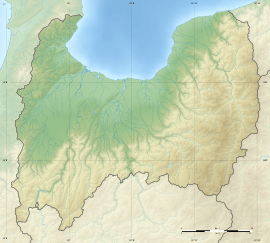Jōbenoma Site
Jōbenoma Site (じょうべのま遺跡, Jōbenoma iseki) is a Heian period archaeological site consisting of the ruins of a shōen located in what is now part of the town of Nyūzen in the Hokuriku region Japan. It has been protected by the central government as a National Historic Site since 1979.[1]
じょうべのま遺跡 | |
 Location in Japan  Jōbenoma Site (Japan) | |
| Location | Nyūzen, Toyama, Japan |
|---|---|
| Region | Hokuriku region |
| Coordinates | |
| Type | settlement |
| History | |
| Founded | 9th century |
| Periods | Heian period |
| Site notes | |
| Condition | ruins |
| Ownership | National Historic Site |
| Public access | Yes |
Overview
The site is located at the eastern end of Toyama Bay on the right bank of the delta of the Kurobe River. Discovered in 1941, full-scale archaeological investigation did not begin until the 1970s. In total, the remains of 21 buildings were confirmed, with an estimated age from the 9th to the 10th centuries. The buildings were reconstructed at least six times during this period. The buildings were arranged in a U-shape around a large main building, which is presumed to be the manor house of a shōen. Artefacts discovered included Sue ware and Suzu ware pottery shards, wooden note tags, glazed pottery shards and fragments of agricultural implements. From historical records, and the discovery of shards of Chinese blue and white celadon porcelain also found at the site, it is believed that this shōen was part of the estates held by either the temple of Tōdai-ji or of Saidai-ji in Nara.
The site has been excavated 17 times since 1970, so the complete area is now clear. Its is one of the few manor sites from the Heian period thus found in Japan. A stream with a width of 30 meters once flowed from the south to the north through the site, with the building complex surrounded by walls on the west bank.
The site is now a public archaeological park, which has been open to the public since April 1990, with concrete pillars marking the locations of foundation posts.
References
- "じょうべのま遺跡". Cultural Heritage Online (in Japanese). Agency for Cultural Affairs. Retrieved 25 December 2017.(in Japanese)
External links
- Toyama Prefectural Tourist information (in Japanese)
- Nyūzen town official site (in Japanese)